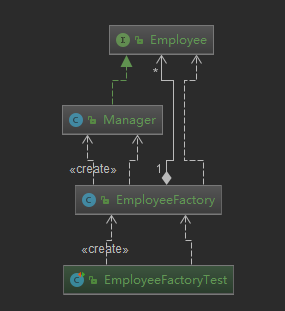# 享元模式 Flyweight
定义:提供了减少对象数量从而改善应用所需的对象结构方式
运用共享技术有效地支持大量细粒度的对象。
简单说,减少对象的创建,降低内存占用,提供系统性能
类型:结构型
# 适用场景
常常应用于系统底层的开发,以便解决系统的性能问题
如:JAVA string,有则返回,无则创建 字符串,并放入缓存里 如:连接池
系统有大量相似对象、需要缓冲池的场景
简单说:有大量需要被共享的时候,才有意义使用享元模式,否则就是杀鸡焉用牛刀
# 优点
减少对象的创建,降低内存中对象的数量,降低系统的内存,提高效率
减少内存之外的其他资源占用
其他资源?操作系统中的文件句柄,除了对象占用内存外,还占用系统资源
# 缺点
- 关注内/外部状态、关注线程安全问题
- 使系统、程序的逻辑复杂化
# 扩展
- 内部状态:在享元对象内部,不会随着环境的改变而改变的部分
- 外部状态:随着环境改变而改变的就属于外部状态,是不可共享的状态
举例来说:一个滑雪板,内部状态:名称=滑雪板,外部状态:租借价格,根据 VIP 级别价格是随着 VIP 级别改变而改变的,普通人来租借滑雪板需要 100, vip 来租借就只需要 50,而内部状态始终都不会变化。
# 相关设计模式
代理模式
如果代理模式生成的一个类花费时间比较多,适合场景下就可以使用享元模式来提高处理速度
单例模式
容器单例,复用对象
# 代码
场景:慕课让各个部门经理做报表;
如果该部门经理对象已经生成过了,就不需要再生成了,也会结合工厂模式
/**
* 员工接口
*
* @author : zhuqiang
* @date : 2018/12/25 22:58
*/
public interface Employee {
void report();
}
// 经理
public class Manager implements Employee {
/**
* 部门固定
*/
private String department;
/**
* 报告内容经常变更
*/
private String reportContent;
public Manager(String department) {
this.department = department;
}
public String getDepartment() {
return department;
}
public void setReportContent(String reportContent) {
this.reportContent = reportContent;
}
@Override
public void report() {
System.out.println(reportContent);
}
public void setDepartment(String department) {
this.department = department;
}
}
2
3
4
5
6
7
8
9
10
11
12
13
14
15
16
17
18
19
20
21
22
23
24
25
26
27
28
29
30
31
32
33
34
35
36
37
38
39
40
41
/**
* 享元工厂
*
* @author : zhuqiang
* @date : 2018/12/25 23:02
*/
public class EmployeeFactory {
private final static Map<String, Employee> EMPLOYEE_MAP = new HashMap<>();
public Employee getManger(String department) {
Manager manager = (Manager) EMPLOYEE_MAP.get(department);
if (manager == null) {
manager = new Manager("department");
System.out.print("创建部门经理 " + department);
String reportContent = " 部门汇报:内容是...";
manager.setReportContent(reportContent);
System.out.println(" 创建报告 " + reportContent);
EMPLOYEE_MAP.put(department, manager);
}
return manager;
}
}
2
3
4
5
6
7
8
9
10
11
12
13
14
15
16
17
18
19
20
21
22
测试,可以看到当使用次数多,假如创建报告是很费时间的,那么这里就能节省很多时间, 但是,这里我怎么感觉和缓存一样呢?难道说缓存就是享元模式么
// 假设有 4 个部门
private String[] departments = {"RD", "QA", "BI", "DB"};
@Test
public void fun1() {
// 总共做十次汇报,每次随机叫一个经理做
// 这里的内容都是一样的
EmployeeFactory factory = new EmployeeFactory();
for (int i = 0; i < 10; i++) {
int index = (int) (Math.random() * departments.length);
factory.getManger(departments[index]).report();
}
}
=====================
创建部门经理 QA 创建报告 部门汇报:内容是...
部门汇报:内容是...
部门汇报:内容是...
创建部门经理 DB 创建报告 部门汇报:内容是...
部门汇报:内容是...
部门汇报:内容是...
创建部门经理 BI 创建报告 部门汇报:内容是...
部门汇报:内容是...
部门汇报:内容是...
部门汇报:内容是...
部门汇报:内容是...
创建部门经理 RD 创建报告 部门汇报:内容是...
部门汇报:内容是...
部门汇报:内容是...
2
3
4
5
6
7
8
9
10
11
12
13
14
15
16
17
18
19
20
21
22
23
24
25
26
27
28
29
30

关于内部外部状态这个例子,让我有点懵逼,可能是这个例子太简单了,不太好阐述清楚;
示例中说:如果再给经理对象增加一个属性 title = “部门经理” ,那么这个 title 就是内部状态,因为是不变的,而部门名称是通过外部传入的就是外部状态。
# 源码解析
java.lang.Integer#valueOf(int)
在范围内则从缓存中获取,这就是一个享元模式的使用
// range -128 to 127
public static Integer valueOf(int i) {
if (i >= IntegerCache.low && i <= IntegerCache.high)
return IntegerCache.cache[i + (-IntegerCache.low)];
return new Integer(i);
}
2
3
4
5
6
org.apache.commons.pool2.impl.GenericObjectPool
@Override
public T borrowObject() throws Exception {
return borrowObject(getMaxWaitMillis());
}
public T borrowObject(final long borrowMaxWaitMillis) throws Exception {
assertOpen();
final AbandonedConfig ac = this.abandonedConfig;
if (ac != null && ac.getRemoveAbandonedOnBorrow() &&
(getNumIdle() < 2) &&
(getNumActive() > getMaxTotal() - 3) ) {
removeAbandoned(ac);
}
PooledObject<T> p = null;
// Get local copy of current config so it is consistent for entire
// method execution
final boolean blockWhenExhausted = getBlockWhenExhausted();
boolean create;
final long waitTime = System.currentTimeMillis();
while (p == null) {
create = false;
p = idleObjects.pollFirst();
if (p == null) {
p = create();
if (p != null) {
create = true;
}
}
if (blockWhenExhausted) {
if (p == null) {
if (borrowMaxWaitMillis < 0) {
p = idleObjects.takeFirst();
} else {
p = idleObjects.pollFirst(borrowMaxWaitMillis,
TimeUnit.MILLISECONDS);
}
}
if (p == null) {
throw new NoSuchElementException(
"Timeout waiting for idle object");
}
} else {
if (p == null) {
throw new NoSuchElementException("Pool exhausted");
}
}
if (!p.allocate()) {
p = null;
}
if (p != null) {
try {
// 通过 工厂操作
factory.activateObject(p);
} catch (final Exception e) {
try {
destroy(p);
} catch (final Exception e1) {
// Ignore - activation failure is more important
}
p = null;
if (create) {
final NoSuchElementException nsee = new NoSuchElementException(
"Unable to activate object");
nsee.initCause(e);
throw nsee;
}
}
if (p != null && (getTestOnBorrow() || create && getTestOnCreate())) {
boolean validate = false;
Throwable validationThrowable = null;
try {
validate = factory.validateObject(p);
} catch (final Throwable t) {
PoolUtils.checkRethrow(t);
validationThrowable = t;
}
if (!validate) {
try {
destroy(p);
destroyedByBorrowValidationCount.incrementAndGet();
} catch (final Exception e) {
// Ignore - validation failure is more important
}
p = null;
if (create) {
final NoSuchElementException nsee = new NoSuchElementException(
"Unable to validate object");
nsee.initCause(validationThrowable);
throw nsee;
}
}
}
}
}
updateStatsBorrow(p, System.currentTimeMillis() - waitTime);
return p.getObject();
}
2
3
4
5
6
7
8
9
10
11
12
13
14
15
16
17
18
19
20
21
22
23
24
25
26
27
28
29
30
31
32
33
34
35
36
37
38
39
40
41
42
43
44
45
46
47
48
49
50
51
52
53
54
55
56
57
58
59
60
61
62
63
64
65
66
67
68
69
70
71
72
73
74
75
76
77
78
79
80
81
82
83
84
85
86
87
88
89
90
91
92
93
94
95
96
97
98
99
100
101
102
103
104
105
通过各种判断,缓存中,再结合工厂管理生命周期,这个也可以看成是享元模式的一个应用
public interface PooledObjectFactory<T> {
// 创建
PooledObject<T> makeObject() throws Exception;
// 注销
void destroyObject(PooledObject<T> p) throws Exception;
// 验证
boolean validateObject(PooledObject<T> p);
// 激活
void activateObject(PooledObject<T> p) throws Exception;
// 钝化
void passivateObject(PooledObject<T> p) throws Exception;
}
2
3
4
5
6
7
8
9
10
11
12
13
14
15
← 适配器模式